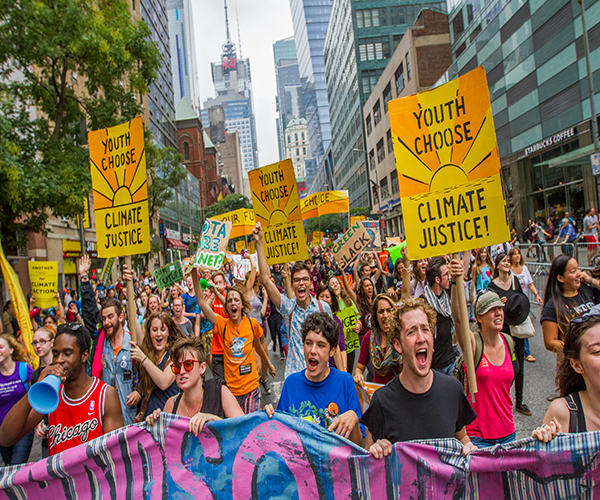Climate change sparks discussion among South students

Courtesy of Shadia Fayne Wood | Survival Media Agency
MARCHING FOR THE MOVEMENT: Over 40,000 people gathered in New York City in September 2014 to rally and protest for climate justice, making it the largest action on climate in history. The march was successful in changing the notion that climate does not affect our lives personally, a misconception that many South students are attempting to eliminate through increased discussion and awareness.
March 11, 2016
In light of recent headlines involving environmental issues and reform, some South students have taken the initiative to learn more about climate change and take part in the world-wide discussion surrounding the matter.
At South, the percentage of students who claim they are informed on the issue is lower than some might expect. In fact, based on an unscientific Oracle-conducted survey of 284 students, only 24 percent said they are “well informed about climate change and follow the issue closely”.
Junior Max Shapiro finds himself to be increasingly passionate about the issue of climate change, spending time gathering related information. According to Shapiro, students should not hesitate to get involved with climate change action.
“One of the most important things to do is […] to be following current events,” Shapiro said. “The National Oceanic and Atmospheric Administration (NOAA) just reported that 2015 was the warmest year on record, [but] people are ignoring this, and they are just passing it off as a normal cycle, which is a problem because we are going to start seeing the effects [of climate change] soon.”
Similar to Shapiro, freshman Gabriel Augustynowicz believes that climate change affects everyone. He encourages students not to be “passive bystanders” when it comes to taking action to combat climate change. Also, he believes every person should be aware of the global community they are contributing to environmentally.
“It’s important for GBS students to be a part of this process, to be cognizant of how the world around them is being changed by human actions, and to work towards a more sustainable path,” Augustynowicz said.
Like Augustynowicz, Shapiro agrees that South students should be engaged in climate change action, but feels that communication with young people is absent, which can lend itself to a growing lack of awareness.
“I haven’t really seen a lot of activity in terms of educating younger people on this issue, and I think that’s a big problem,” Shapiro said. “There is an Earth Day, which is a good thing, but it’s just not where we need to be.”
Further elaborating on Shapiro’s call for an increase of education pertaining to the environment, Augustynowicz adds realistic suggestions for increasing student understanding of the effects of climate change on the local and global communities.
“I think that GBS already has a great introduction to climate change,” Augustynowicz said. “[…] Another way to educate students would be to show them the effects of climate change on their own lives and community. Having students measure temperatures over the years, and watch as the mean rises, would be a tangible effect [on students’ understanding of the environment].”
According to the U.S. Environmental Protection Agency (EPA), one such way to effectively teach students about the impact of climate change is by using their Climate Change Emission Calculator Kit (Climate CHECK). This tool, according to EPA’s website, is designed to help students “estimate their school’s greenhouse gas emissions and identify ways to mitigate their school’s climate impact,” and is a practical resource that South students can utilize (see QR code below).
A student who has taken the initiative to actively raise awareness regarding climate change is senior Jordan Chiappetta, co-president of Project Earth Club at South. One of the reasons why she has been involved with Project Earth for the past four years is her motivation to see local change in the community as a direct result of her and her peers’ efforts.
“People have to start taking measures and questioning the way they live to make a difference,” Chiappetta said. “[…] On a very basic level, we’re causing [environmental issues] with our actions everyday.”
According to Chiappetta, involvement in Project Earth teaches students to care about the immediate impact they have on climate change. She explains that the club partners with the Village Natural Resource Commission and is involved with Eagle Scout projects, Chicago River Clean-up Day and Arbor Day, to name a few. Aside from all the events Project Earth participates in, Chiappetta explains that experiencing the impact of climate change is inevitable amongst younger people.
“We’re beyond the point of prevention, and now we just need to live with the effects [of climate change],” Chiappetta said. “People are starting to feel it and starting to raise the issue.”
Students who aim to get involved with climate change on a broader scale can join groups such as 350, an organization dedicated to “building a global grassroots climate movement that can hold leaders accountable to the realities of science and the principles of justice,” according to the organization’s website, 350.org.
350 has a local branch, Chicago350, in which students can engage in a variety of projects that are specific to the Chicagoland area. Examples of volunteer opportunities include attending monthly meetings, planning marches to mobilize support against the fossil fuel industry and showing films regarding climate change at locations around the community.
Shapiro echoes Chicago350’s notion that it is the responsibility of younger people to recognize and work towards the betterment of the environment. He stresses the impending consequences of climate change and urges other young people not to neglect environmental issues any longer.
“Over the next 50 years, you’re going to see actual real- world effects coming from global warming,” Shapiro said. “You’re going to see the seas start to rise, heat waves, stronger hurricanes, diseases spreading. This is an issue that we’re going to have to start dealing with.”


